
My last post got me thinking about the many savoury and sweet breads in Mexico; one that may be enjoyed both ways, and that also has a very interesting history, is the bisquet, named after the American-style biscuit. This is a somewhat long but, honestly, very interesting story, so I could not shorten it any more without losing vital details. (If you need/want the recipes ASAP, the most relevant are: Southern Angel Biscuits, Classic Mexican Bisquets , and my Low-fat Quick Bisquets.)
About the name – The word “biscuit” originally comes from the Latin form biscoctus – twice cooked, from the technique of baking dough until cooked, and then giving a second heat treatment to obtain a crisp and somewhat dry piece; Italian biscotti (the plural of “twice-cooked” in Italian, biscotto) are a very good example. In England, a biscuit is what would be called cookie in the US and, come to think of it, we actually use both words in Canada (e.g., chocolate chip cookies, digestive biscuits). Puffier versions were called “soft biscuits”, but later shortened to simply “biscuit” in some places, whereas the crispy confections generically became cookies, from the Dutch koekje – little cake. In England, buttery and soft small baked goods may be – depending on fat/flour ratios – soft biscuits, American-style biscuits, or scones.
About the texture and flavour – Southern states in the United States, such as Georgia and Tennessee, have mild winters and long summers, which result in wheat crops that produce flour with a lower protein content than in colder regions. This in turn made fluffier biscuits, also aided by the generous amounts of fat characteristic of the Southern recipes. Around the mid 1800s, baking soda and baking powder allowed these confections to be baked without yeast, acquiring the name of “quick breads.”
About their creation – In the later 1800s and early 1900s, many Chinese immigrants first joined the Gold Rush in California, and shortly after, the work force building the Transcontinental Railroad, as well as other railroad projects in Northern Mexico. When these jobs dwindled, many went back to China – voluntarily or, sadly, by deportation – while others tried to integrate themselves under more hospitable conditions, finding jobs in other trades, such as the food industry. In Mexico City, small restaurants run by Chinese immigrants were affordable, becoming popular amongst students and families, but were also attractive to many others for the novelties on the menu, which their Chinese owners had discovered while working in the United States, such as Southern biscuits. These delicious and flaky pastries were served buttered with jam, or as a savoury side, usually paired not with tea, but with a tall glass of strong coffee mixed with frothy milk (café con leche) catering to the local preferences. People started calling these establishments “cafés de chinos” (Chinese cafes); some of them, such as “El Popular” (The Popular) founded in 1948, are still around. “Los Bisquets Obregón” started in 1945 as a small restaurant called “La Perla de Oriente” (Pearl of Orient); it is currently 100% Mexican and a very successful chain, with restaurants in several Mexican states.
About the recipe – Even though bisquets were inspired by American biscuits, I remembered them as more flaky and not as fatty; when I looked up recipes, I found that most modern bisquet recipes call for butter, while older ones use lard or shortening, achieving flakiness through rolling and folding of the dough; the fat content is, in fact, not that different from American biscuits. The surprising common denominator for bisquet recipes, though, was the use of baking powder AND yeast; how had this quick bread become “slow” and why? The answer, which reaffirmed its American background, came from a recipe I found for something called Angel Biscuits, which were most likely invented at one of those fine southern flour millers in Tennessee, maybe White Lily™, since they also have a recipe on their website. In addition to the soft Southern flour used to make them (called “cake flour” in the USA and Canada, with a low protein content, about 8-10%), Angel biscuits owe their airiness both to rolling and folding the dough, and to staggered leavenings: yeast, sometimes baking soda, and baking powder. I was very confident now about my findings on the Mexican bisquet history, because these are the only two recipes I have ever seen that call both for yeast and baking powder. In fact, the Mexican recipes were basically the same as the Angel biscuits, except for the use of a mix of eggs, sugar and milk (readily available and inexpensive in Mexico) instead of buttermilk; they still had the yeast as an extra leavening agent. Everything finally fell into place.
About my recipe – I was, however, not very happy about the amount of fat in the recipes, so I did not feel motivated to try either of them. Instead, I have adapted a low-fat biscuit recipe I had cut out from an old Woman’s Day magazine (October 1996, sorry, not on-line!), which already calls for cake flour, and has a two-stage leavening, but with baking soda and baking powder, and requires only about half the butter of the Angel biscuit recipe. As in bisquet recipes, I omitted buttermilk, using a mix of low-fat yogurt and skim milk instead. I also omitted sugar in my bisquet dough, plus there is no yeast, so no waiting. Great! A taste and flaky texture similar to Mexican bisquets and Southern Angel biscuits, with a fraction of the fat, and reduced cooking time … a deal made in heaven!
Science Tidbit – The reasoning behind choosing a particular type of leavening may be explained by how, and when, each one is activated. Yeast is a living organism that feeds on sugar, causing fermentation, and hence forming bubbles before baking. That is why the dough needs to rest and how it doubles its size outside the oven. Baking soda is an alkaline compound that reacts with acidic ingredients in the mix, such as buttermilk, molasses or fruit, and a product of this chemical reaction is again bubbles, which are produced fast and as soon as the baking soda touches the acidic substance, so there is no need to wait before baking. Finally, baking powder is a mix of baking soda, an acid (usually cream of tartar), and a stabilizer (such as corn starch). Hence, this leavening agent works within itself, even if there is no acidic ingredients in the batter; the reaction is activated when the stabilizer gets wet and then cooked away through heat, which means that the rising will mostly take place during baking. For an extra fluffy crumb, the Angel biscuit and bisquet recipes use yeast, acting before baking, and baking powder, rising the dough during baking. In my recipe, baking soda takes the role of the yeast, turning it into a quick bread, and it also includes a good amount of baking powder, so it has that second rising stage in the oven.
Low-fat Quick Mexican Bisquets
Printable recipe: Low-fat Quick Bisquets
Ingredients
2 cups cake flour (8-10% protein), plus more as needed
1 tbsp baking powder
¼ tsp baking soda
¼ tsp salt
¼ cup butter, or non-hydrogenated margarine
½ cup low- fat plain yogurt
¼ cup milk, skim or 1%
1 egg, for brushing
1 tsp sugar, optional
Preheat oven to 375°F (190°C). Prepare a baking sheet lined with parchment paper, set aside. Mix yogurt and milk in a cup, and set aside. In a large bowl, mix: flour, baking powder, baking soda and salt. Add butter (or margarine) to dry ingredients:
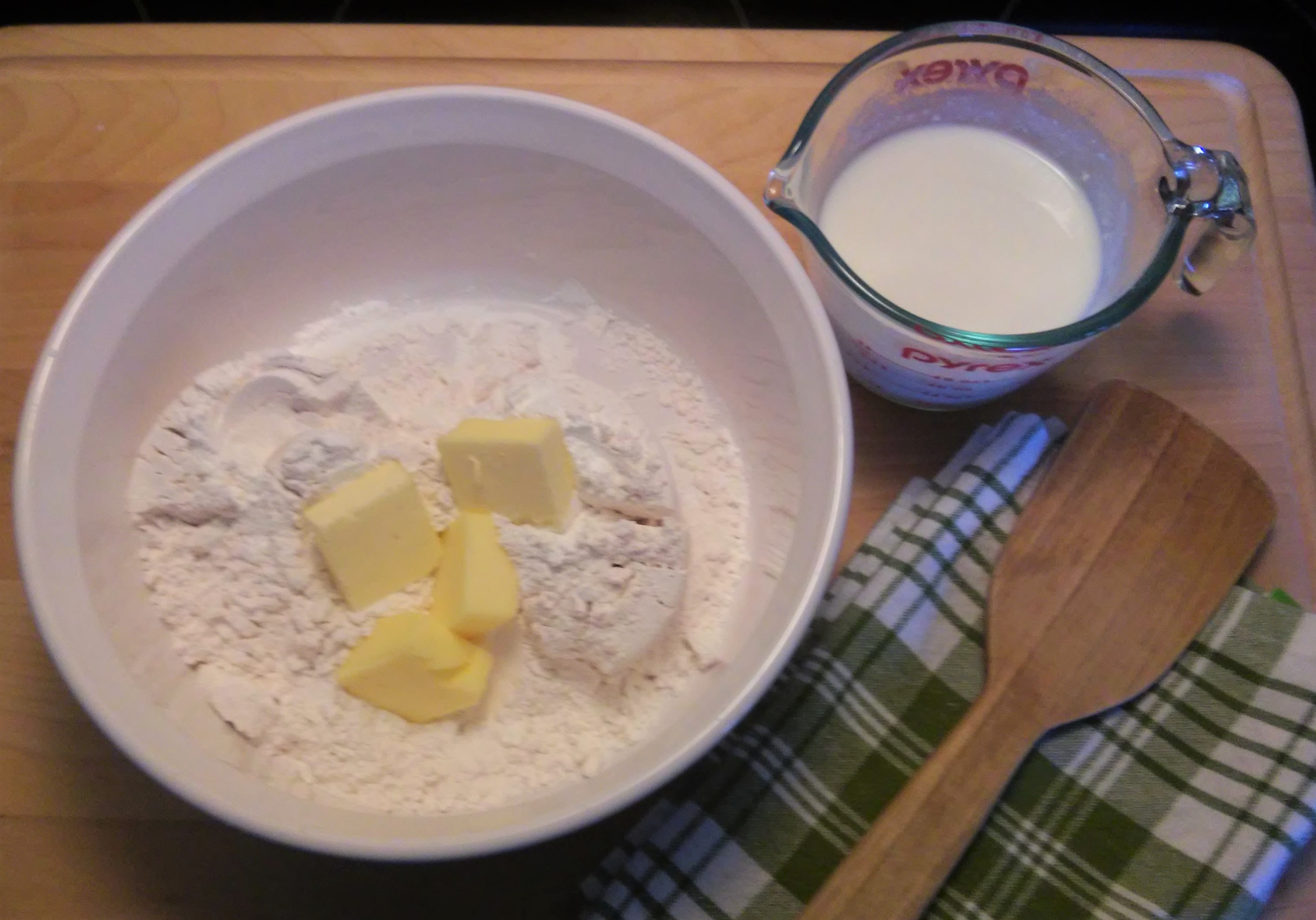
Cut butter in with a pastry blade or wooden spatula, incorporating with the dry ingredients until a sandy texture is reached. Stir in yogurt mix with a fork, then turn onto a floured surface, and lightly knead to form a ball:
With a floured rolling pin, roll dough into a 10×6-inch rectangle. Fold short ends to meet in the centre:
Fold in half to form a 2.5X6-inch block. Rotate block ninety degrees, then repeat rolling and folding. Rotate again, then roll into a 6-inch square. Mark a 4×4 grid and slice with a knife into 16 squares, using straight downward motions for clean cuts:
Alternatively, use a 2-inch diameter round cookie cutter or glass rim to obtain 9 discs, then use a small bottle cap or mini cookie cutter to mark a circle in the middle of each disc. Traditional Mexican bisquets are shaped like this, as two concentric circles (photo at the top of the post). I made 8 squares and 8 1.5-inch small circles with a heart shaped mark in the middle, to illustrate the options. Arrange on prepared sheet. In a small bowl, beat egg (with sugar, if using) and brush biscuits:

Bake in preheated oven for about 12 minutes, until golden brown and crispy:
Photo at the top of the post: Basket with Mexican sweet breads, featuring a bisquet (left) and a cuerno (croissant). Tacubaya, Mexico City, 2012.



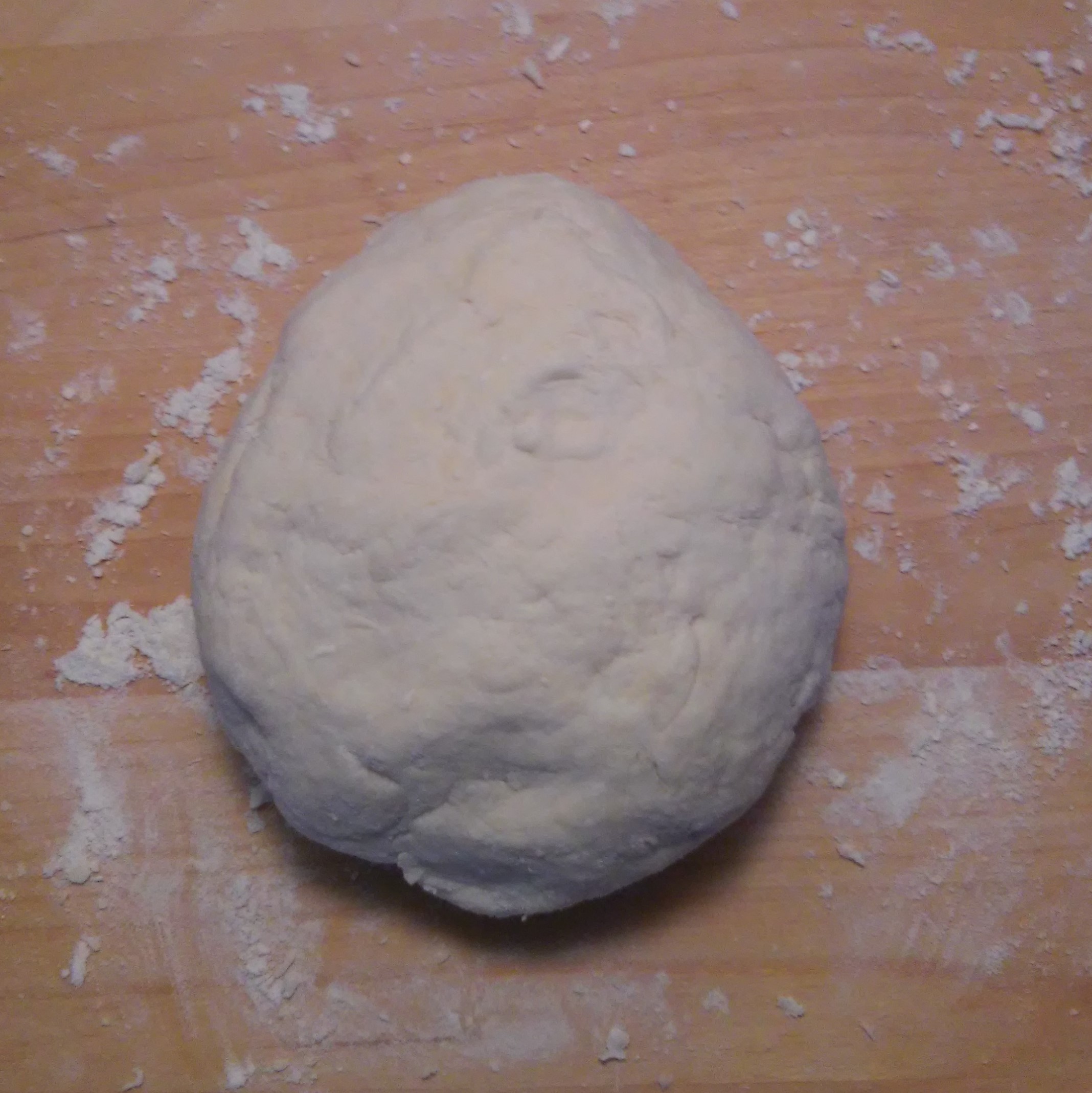

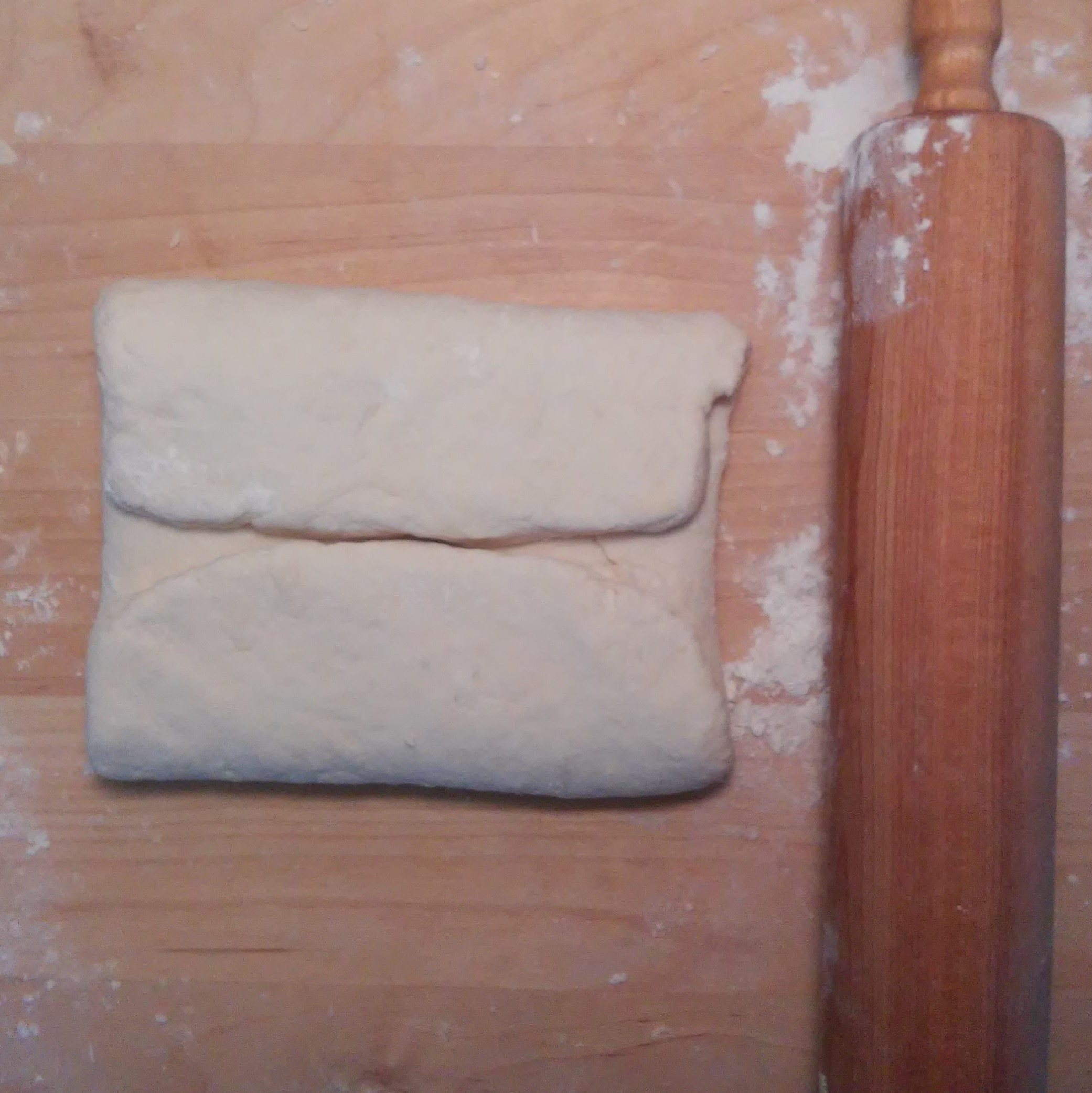


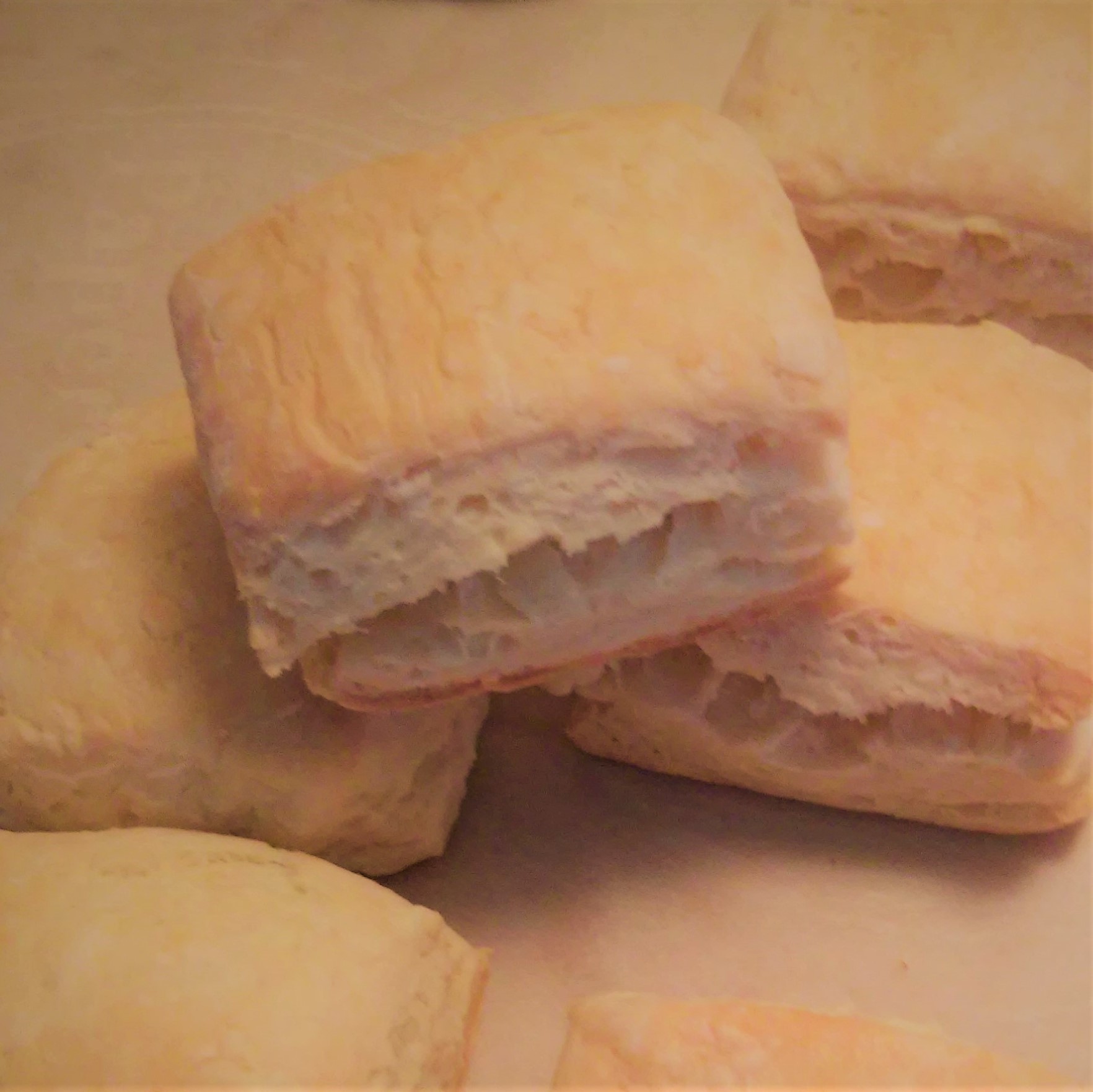


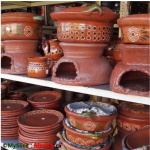




Fascinating history, both about biscuits and about leavenings. Very interesting!!
LikeLiked by 2 people
I agree with Eilene. its too hot to bake by my standards, but I will keep these in mind.
LikeLiked by 1 person
Yeah, it is hot, maybe for now just a panque con pasas, LOL
LikeLiked by 1 person
With a good glass of cafe con leche. Breakfast of champions!
LikeLiked by 1 person
I’ll have to come back and re-read your post, Irene. Lots of interesting information here. In Australia, we eat biscuits, or bikkies for short.
LikeLiked by 1 person
It was a very interesting process for me as well, as every piece of information became relevant and fell into place. Are the crispy treats called biscuits as well? We have Tim Tams here and the description says it is a sandwich with two biscuits.
LikeLike
Mostly, they are still biscuits, but the term crackers has crept in of late for things like rice crackers and other types of crispy biscuits we might have with cheese and other savoury foods.
Ah TimTams. I haven’t had them for years. I used to adore dipping a Tim Tam in my cup of tea. )
LikeLiked by 1 person
oh wow, my stomach grumbles just looking at this. It looks so yummy
LikeLiked by 1 person
I know; now I am curious and maybe I will go back and try the original recipes just to see how big of a difference the fat and yeast make
LikeLiked by 1 person
thought you might like this. With butter and 1 reg egg and nonfat skim milk, I got these calorie counts with the ingredients (I used cronometer.com and just plugged everything in. It’s free.)


nutritional values
That’s a total of 1564 calories. I counted you sectioned it into 16 pieces so 1564/16 = 97.75 calories per piece
Asians use egg white to brush, not the whole egg. So I tried it again with margarine instead of butter, 1 egg white and nonfat skim milk. For margarine I chose “margarine, diet, fat free” There are a lot of choices with margarine because you can choose 50% less fat, 60%, 30%, etc. And you got these:


nutritional values
Your calorie count drops down to 1129 calories. So individually 70.6 calories per piece. Your fat numbers though drop out of the red. Both ways, get a lot of salt but it doesn’t look like nutritionally, the vitamins and minerals change much.
By individual piece, it’s only a 27 calorie difference. With the nutritional values, you have to divide by 16 too. So while the sodium and fat numbers look bad, divided by 16, they are actually pretty low, I think, for delicious looking bread. I’d feel comfortable eating this on my diet in a week or two — but I’d have to give away the other 15 pieces away if I baked them before I ate them too. Eating all 16 would totally kill the diet, lol.
I love the Chinese-Mexican/American history as I am Asian American.
LikeLike
Wow, thanks for the nutritional analysis, it validates the effort to cut back on fat! I think it would be possible to freeze them, and just take a single portion out every now and then, thawing/reheating in a toaster oven. I was very pleased when I learned that those immigrants could find a niche in Mexico; my grandparents planned to go back to Japan after WWII, but there was little to go back to, so they opened a convenience store in Mexico City instead.
LikeLiked by 1 person
I know Chinese immigration started in the 1500s along with the Spaniard galleon trade and that there was a lot of Japanese immigration to Brazil right after WWII. Was there much Japanese immigration to Mexico and when did it start? do you know? What part of Japan did your grandparents come from?
LikeLike
There were some Japanese and Okinawan amongst the generically called Chinese immigrants in old times. Mexico became a country in 1821, and was the first in the continent to have a formal treaty with Japan (1888). The first organized migration to Mexico was in 1897, I think mostly coffee farmers in Chiapas; then my grandfather arrived in the second wave as a miner, in the early 1900s; and the third, was after WWII, since Mexico was one of the first countries to re-establish relations with Japan. My grandparents were from Fukushima. My dad was a Japanese immigrant, as well; he arrived in Mexico from Yamaguchi a couple of years before WWII to work for a Japanese company. There are all sorts of interesting stories about Japanese-Mexican relations, I should post some soon. What is your background?
LikeLiked by 1 person
My mom was Okinawan and she married my dad who was a GI stationed in Okinawa. He is Norwegian, and French Canadian. His grandmother came from Norway. The French Canadian may have Native American and some other European mixed in as I don’t know when they immigrated to Canada or much about that sideo fhte family.
LikeLike
That is a very interesting background; so you are part Canadienne, non? 🙂
LikeLiked by 1 person
Yes, on my father’s father side. That’s where my french last name came from.
LikeLiked by 1 person
Loved the origin story.
LikeLiked by 1 person
Me, too. A true example of positive globalization
LikeLiked by 1 person